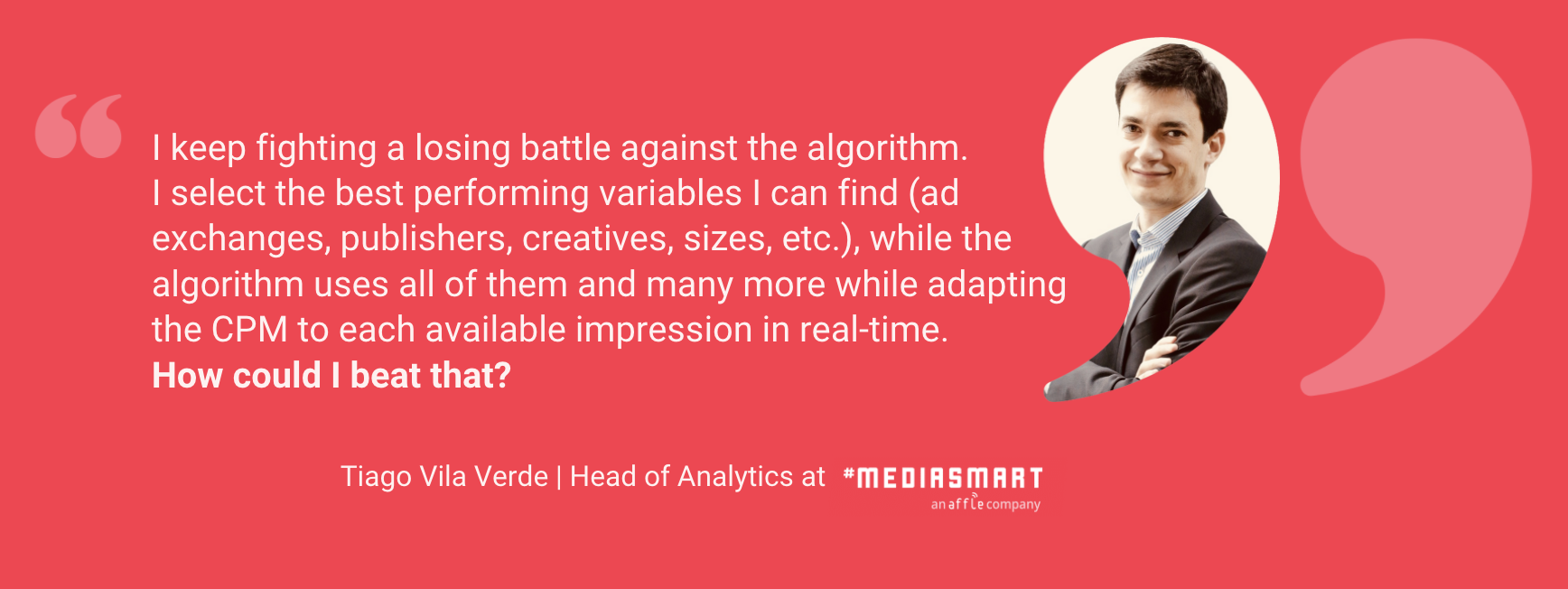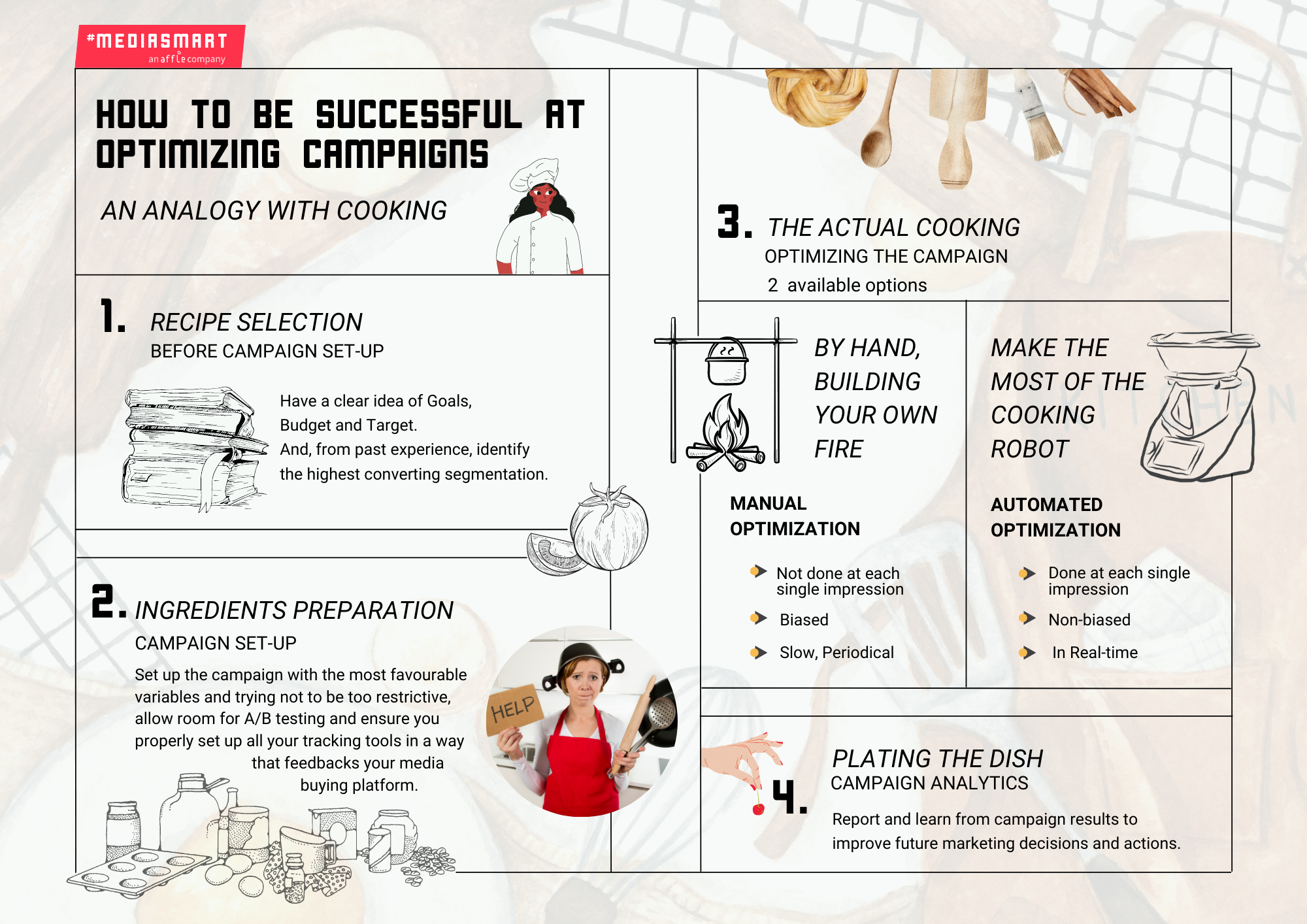Blog
Announcements, analysis and opinions on industry trends around the mobile programmatic world.

Subscribe now, and receive the latest programmatic content directly on your inbox!
Thank you for subscribing to our newsletter
As a marketer running programmatic advertising campaigns, you can face certain challenges that result in low conversion rates and inefficient budget allocation. In general, these challenges are related to a non-transparent view of the campaign data to optimize and control results, to which you have to add long hours of data analysis.
You will need more insights into specific patterns and current activities to optimize your ad campaigns and allocate your marketing budget more efficiently through optimization. Should it be manual or automated? In this article, we will cover what optimization means, the manual and the automated side of it and which one is better for your campaigns.
What does it mean to optimize a campaign?
According to the Oxford dictionary, Optimization is the act of making the best or most effective use of a situation or resource. In Advertising and more specifically in AdTech, optimisation allows you to enhance the performance of advertising campaigns. It is usually conducted by A/B testing and making adjustments to marketing strategies such as pricing, publisher lists, audience targeting, etc. to achieve desired marketing and business outcomes. This means:
- Measuring and learning what works and what doesn’t to improve and adjust campaigns accordingly.
- Fine-tuning the content and the targeted segment, with more relevant content compelling to a target audience that will get your desired results.
- Discovering new customer segments, interested in your offering and expanding the top funnel of customers.
There are two different kinds of optimizations: the ones that are done manually (i.e. you know what segments convert for your product so you target your campaign to them) and the ones that are done automatically via machine learning. This means that algorithms will make informed decisions, usually in real-time, to improve campaign results.
What is automated optimization?
In automated optimization, machine learning and algorithms do all the heavy lifting for you, provided everything is in place for said technology to function properly.
Machine learning talks about training machines the ability to learn without any human intervention and developing learning modules to train themselves to improve their learning ability. These learning modules are developed by using data (both input and output) and different algorithms. The machine creates its own logic based on a set of rules that a developer programmed, which is evaluated through testing.
Algorithms are a set of rules that are followed by machines for problem-solving operations to get the expected output; they play a major role in programmatic media buying. In layman's language, the instructions or recipe that you read while cooking is the machine’s algorithm. The ingredients are your data sets, the recipe book is your learning module and the final dish is the expected output: conversion goals of the campaign. And, the machine keeps learning following the precepts of machine learning, the same way you would get better at cooking the more dishes you prepare.
And you might wonder, why would anyone want to use machine-learning or algorithms? Mainly, because the technology would do the cooking for you. Not only that, but it is also able to make unbiased decisions with a lot of data points at the same time and in real-time, which is of great benefit for you as an advertiser. Algorithms need to understand your expected goals and, accordingly, make the right decisions for your campaigns to be efficient: a well-rounded meal. Results will vary depending on how they were programmed, which would be the best-kept secret for any chef - or CTO on a Demand Side Platform (DSP). Mediasmart, as a DSP, has several algorithms that take all the targeting variables into account to buy media, optimize towards CTR or any other cost per conversion/action (CPA).
Imagine you have an e-commerce and you are able to identify which users visited your store in the past, provided with that information, the algorithms would be able to suppress that list of users if the aim was to find new consumers, look for lookalikes if the aim was to reach similar users or target those users in different environments and based particularly on the products they browsed. To optimize that campaign, the system would need to be able to get information on the expected conversion, like a purchase on the e-commerce and also learn where the users are: what publishers (apps or webs) they visit and many other targeting variables like operating system, geolocation, weather, etc. to see which of them convert better and follow that pattern to improve overall results. There will be a learning period, decision making, and more learning as time passes by to get you better results.
What is manual optimization?
With manual optimization, the goal is the same, only you will be responsible for making all the adjustments: what ad is to be served in which publisher, what price you are willing to pay for a particular impression on a particular app, etc.
In general, campaigns will benefit from some level of manual optimization, especially at the very beginning where it is expected you, as the marketing manager or trader for a particular brand, will have a better idea of who your targeted and best converting segments are. You should help the machine get ready to achieve the best results. If you define from the beginning of any campaign who you want to target: create suppression lists of users that have already converted or use them for lookalike strategies, be as broad as possible with the targeting to increase the chances of good results…the chances of success exponentially improve.
Nevertheless, it is true that damage could be done by too much manual optimization, like putting too much salt into your dish or too little sugar into your cake. Manual means ‘made by the man’ and as such, it is expected to be fallible. In what instances could it go wrong? The most usual ones we have encountered are related to the pricing and too strict targeting restrictions from the beginning.
In the case of the pricing, it is too low CPM or CPC set at the beginning of a campaign that will not allow for a good learning period, which is essential for algorithms to be able to do their work properly. The same can be said from setting a cost per conversion too early into the game. On the other hand, restrictions and/or some changes brought up in the middle of a campaign will clash with the obtained results, the expected goals and the campaign will get strangled and stop.
Which one is better - automated or manual?
Mediasmart allows you both to automate campaign optimization via the use of our algorithms and/or to manually optimize through our user interface, so we can be as neutral as Switzerland on this dispute.
As mentioned above, a minimum level of manual optimization will increase the chances of success of a campaign. Particularly, if you provide the right segment to target for instance or get the right marketing mix by A/B testing Ad formats, Publishers, Contexts, Data or Pricing. The creativity and the knowledge you can provide as warden of your brand, product or service is certainly high value.
But when you compare “apples to apples”, that is to say, what an algorithm does: check a huge amount of variables in real-time to make decisions to buy one particular impression based on a particular goal (be it CPC, CTR, CPI, CPV, CPA, etc.) to a person doing the exact same job, the comparison is simply “not fair”.
Not only the machine will be faster - and in programmatic you really need to be fast, as a bid request should be answered in between 6 to 16 milliseconds on average - but it will be able to make non-biased decisions for each of the ad spaces open to bidding and in real-time. If that was not enough, in mediasmart, we process on average 1.2 million ad requests per second! Imagine what a workforce of superhumans you would need to optimize that volume of impressions manually.
Because we love to be fair and have actual proof, in a set of internal experiments we regularly perform, our Head of Analytics - Tiago Vila Verde - works against our algorithms. These experiments aim to prove which of the optimization methods works best, manual or automated. In his own words:

If you set up the campaign properly with the right set of parameters that allow for automated optimisation, you will be able to sit back and relax until the whole budget is over. That is not to say that a human doesn’t need to keep an eye, check periodically results if there is A/B testing or the campaign has stagnated and manual optimization could improve its results. Our console not only will enable you to make the most out of your budgets thanks to our algorithms, but also allow you to keep changing variables in real-time if you like to do so.

We recommend you to get continuous results, increase the revenue and achieve your desired results, to rely on machine learning and algorithms - let’s not forget they have been created with the particular goal of optimizing your campaign - while making sure you have the right configuration from the beginning and you check campaign results go according to your expectations to be able to fine-tune manually, only if necessary.
Topics: machine learning, automation, manual optimization
%20(1).jpg)

